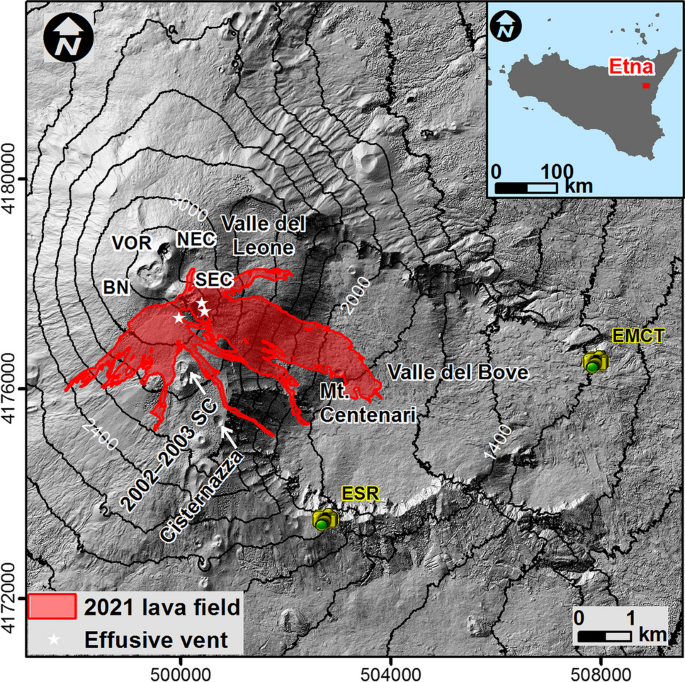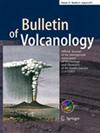快速提供地图和火山学参数:通过多种遥感技术的整合对2021年埃特纳火山熔岩流进行量化
IF 3.2
2区 地球科学
Q1 GEOSCIENCES, MULTIDISCIPLINARY
引用次数: 0
摘要
在活火山上,反复发生的喷发事件,侵蚀过程和崩塌改变了建筑物的形态,影响监测和减灾。2021年2月至10月期间,意大利埃特纳火山东南火山口(SEC)发生了57次突发事件,这是目前最活跃的山顶火山口。斯特隆波利火山活动和高熔岩喷泉(高达4公里)使熔岩流向东部、南部和西南部,并在距离SEC 1 - 2公里的范围内造成了弹道沉降物(直径大于1米)。受影响的地区不包括永久性基础设施,但有成千上万的游客参观。因此,在沉积物被下一次事件覆盖之前,我们迅速绘制了每一次熔岩流的地图,以减轻危险。高频率的瞬变气候需要整合来自三个不同空间分辨率遥感平台的数据。卫星(Sentinel-2多光谱仪、PlanetScope、Skysat和Landsat-8操作陆地成像仪)和无人机图像(可见光和热成像)被处理和整合,以提取数字表面模型和正形图。利用最新的数字表面模型对国家地质火山研究所永久摄像机网络获得的热图像进行了正校正。这种多传感器分析可以汇编一个地理数据库,报告每个熔岩流的主要几何参数。后验分析可以量化熔岩流和SEC变化的体积,以及喷发岩浆的致密岩石等效体积。对无人机数字表面模型的分析使弹道分布的评估成为可能。所开发的方法能够快速准确地描述频繁发生的溢出事件,以便进行近乎实时的风险评估和危害通报。本文章由计算机程序翻译,如有差异,请以英文原文为准。

Rapid provision of maps and volcanological parameters: quantification of the 2021 Etna volcano lava flows through the integration of multiple remote sensing techniques
Abstract At active volcanoes recurring eruptive events, erosive processes and collapses modify the edifice morphology and impact monitoring and hazard mitigation. At Etna volcano (Italy) between February and October 2021, 57 paroxysmal events occurred from the South-East Crater (SEC), which is currently its most active summit crater. Strombolian activity and high lava fountains (up to 4 km) fed lava flows towards the east, south and south-west, and caused fallout of ballistics (greater than 1 m in diameter) within 1–2 km from the SEC. The impacted area does not include permanent infrastructure, but it is visited by thousands of tourists. Hence, we rapidly mapped each lava flow before deposits became covered by the next event, for hazard mitigation. The high frequency of the SEC paroxysms necessitated integration of data from three remote sensing platforms with different spatial resolutions. Satellite (Sentinel-2 MultiSpectral Instrument, PlanetScope, Skysat and Landsat-8 Operational Land Imager) and drone images (visible and thermal) were processed and integrated to extract digital surface models and orthomosaics. Thermal images acquired by a permanent network of cameras of the Istituto Nazionale di Geofisica e Vulcanologia were orthorectified using the latest available digital surface model. This multi-sensor analysis allowed compilation of a geodatabase reporting the main geometrical parameters for each lava flow. A posteriori analysis allowed quantification of bulk volumes for the lava flows and the SEC changes and of the dense rock equivalent volume of erupted magma. The analysis of drone-derived digital surface models enabled assessment of the ballistics’ distribution. The developed methodology enabled rapidly and accurate characterisation of frequently occurring effusive events for near real-time risk assessment and hazard communication.
求助全文
通过发布文献求助,成功后即可免费获取论文全文。
去求助
来源期刊

Bulletin of Volcanology
地学-地球科学综合
CiteScore
6.40
自引率
20.00%
发文量
89
审稿时长
4-8 weeks
期刊介绍:
Bulletin of Volcanology was founded in 1922, as Bulletin Volcanologique, and is the official journal of the International Association of Volcanology and Chemistry of the Earth’s Interior (IAVCEI). The Bulletin of Volcanology publishes papers on volcanoes, their products, their eruptive behavior, and their hazards. Papers aimed at understanding the deeper structure of volcanoes, and the evolution of magmatic systems using geochemical, petrological, and geophysical techniques are also published. Material is published in four sections: Review Articles; Research Articles; Short Scientific Communications; and a Forum that provides for discussion of controversial issues and for comment and reply on previously published Articles and Communications.
 求助内容:
求助内容: 应助结果提醒方式:
应助结果提醒方式:


